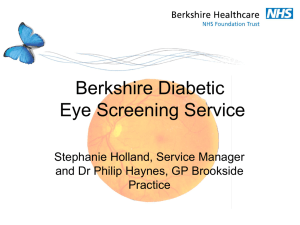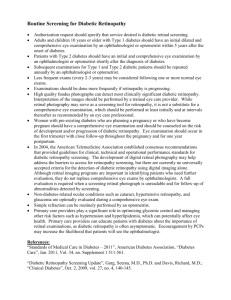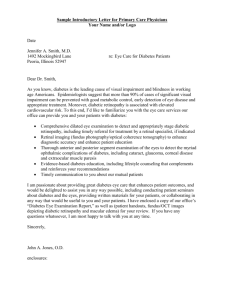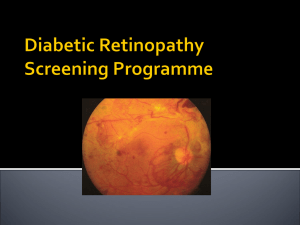Diabetic Eye Screening information sheet for healthcare professionals
advertisement
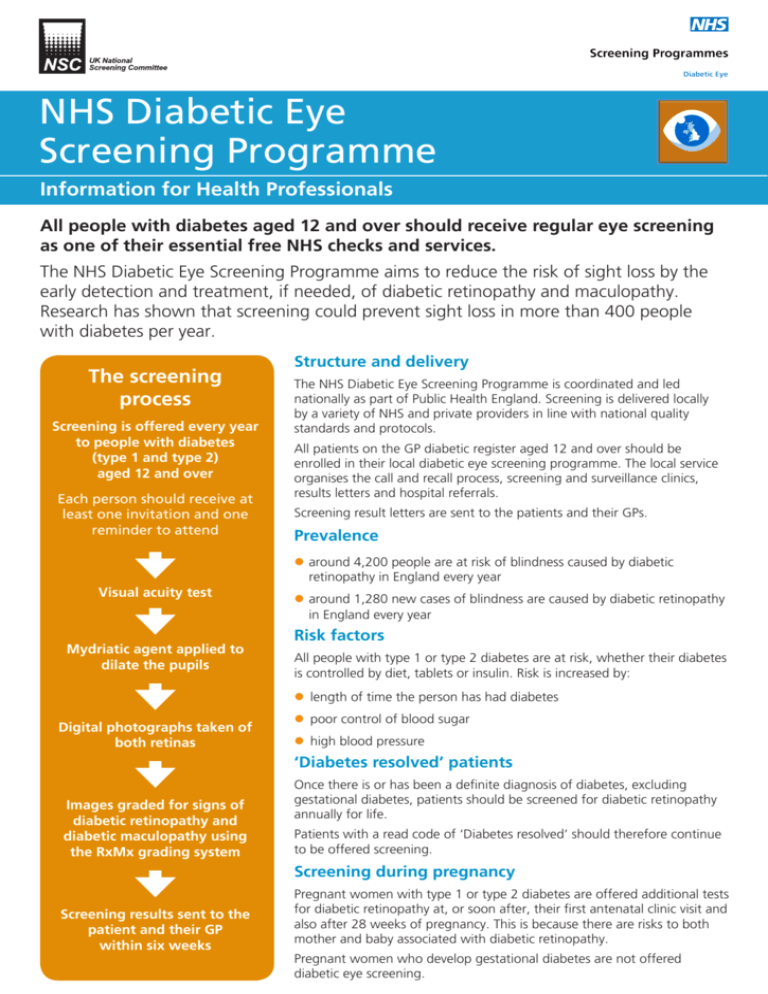
NHS Diabetic Eye Screening Programme Information for Health Professionals All people with diabetes aged 12 and over should receive regular eye screening as one of their essential free NHS checks and services. The NHS Diabetic Eye Screening Programme aims to reduce the risk of sight loss by the early detection and treatment, if needed, of diabetic retinopathy and maculopathy. Research has shown that screening could prevent sight loss in more than 400 people with diabetes per year. The screening process Screening is offered every year to people with diabetes (type 1 and type 2) aged 12 and over Each person should receive at least one invitation and one reminder to attend Structure and delivery The NHS Diabetic Eye Screening Programme is coordinated and led nationally as part of Public Health England. Screening is delivered locally by a variety of NHS and private providers in line with national quality standards and protocols. All patients on the GP diabetic register aged 12 and over should be enrolled in their local diabetic eye screening programme. The local service organises the call and recall process, screening and surveillance clinics, results letters and hospital referrals. Screening result letters are sent to the patients and their GPs. Prevalence laround 4,200 people are at risk of blindness caused by diabetic retinopathy in England every year Visual acuity test Mydriatic agent applied to dilate the pupils laround 1,280 new cases of blindness are caused by diabetic retinopathy in England every year Risk factors All people with type 1 or type 2 diabetes are at risk, whether their diabetes is controlled by diet, tablets or insulin. Risk is increased by: l length of time the person has had diabetes Digital photographs taken of both retinas l poor control of blood sugar l high blood pressure ‘Diabetes resolved’ patients Images graded for signs of diabetic retinopathy and diabetic maculopathy using the RxMx grading system Once there is or has been a definite diagnosis of diabetes, excluding gestational diabetes, patients should be screened for diabetic retinopathy annually for life. Patients with a read code of ‘Diabetes resolved’ should therefore continue to be offered screening. Screening during pregnancy Screening results sent to the patient and their GP within six weeks Pregnant women with type 1 or type 2 diabetes are offered additional tests for diabetic retinopathy at, or soon after, their first antenatal clinic visit and also after 28 weeks of pregnancy. This is because there are risks to both mother and baby associated with diabetic retinopathy. Pregnant women who develop gestational diabetes are not offered diabetic eye screening. The RxMx grading system R0 R1 R2 R3A R3S M0 M1 = No retinopathy = Background retinopathy = Pre-proliferative retinopathy = Active proliferative retinopathy = Stable proliferative retinopathy = No maculopathy = Maculopathy Photographs of the patients’ retinas taken at screening are graded according to national protocol using the RxMx grading system definitions (left). A lead clinician in each local screening service determines the final grade and outcome for the patient. The patient is then either returned to annual screening, referred to a digital surveillance clinic for more frequent monitoring or referred to hospital eye services for more tests and possible treatment. Screening outcome Role of primary care No retinopathy or maculopathy Possible result: Follow-up: R0M0 Reinvited for routine annual screening in 12 months’ time Continue to advise patient on good management of diabetes, including blood glucose, blood pressure and lipid levels. Background retinopathy Possible result: Follow-up: R1M0 Reinvited for routine annual screening in 12 months’ time Ensure patient attends routine diabetes checks at GP practice. Referral to digital surveillance clinic Possible results: Follow-up: R2 M1 R3S Screened in surveillance clinic every 3, 6 or 12 months depending on progression of disease. Referral to hospital eye services Possible results: Follow-up R3A R2 M1 Referred by the local programme to hospital for diagnosis, possible follow-up tests and treatment. Patients are suspended from screening by the local programme while under the care of hospital eye services for diabetic eye disease. They are returned to routine screening or surveillance after discharge. Provide additional advice on good management of diabetes, including blood glucose, blood pressure and lipid levels. Ensure patient attends routine diabetes checks. Invite for additional checks if diabetic control indicates. Refer to diabetologist if indicated. Further information for patients Further information for health professionals lnational leaflets - all people with diabetes aged 12 and over receive a copy of the leaflet, Your guide to diabetic eye screening, with their screening invitation lNHS Diabetic Eye Screening Programme diabeticeye.screening.nhs.uk llocal diabetic eye screening programme - the phone number for the local screening programme is on the screening invitation letters lNHS Diabetic Eye Screening Programme www.nhs.uk/diabeticeye lDiabetes UK - www.diabetes.org.uk lspeak to your local diabetic eye screening programme manager lMap of Medicine - the care pathway for the NHS Diabetic Eye Screening Programme is published on Map of Medicine. See healthguides.mapofmedicine.com lGP Notebook - online medical information available at www.gpnotebook.co.uk
